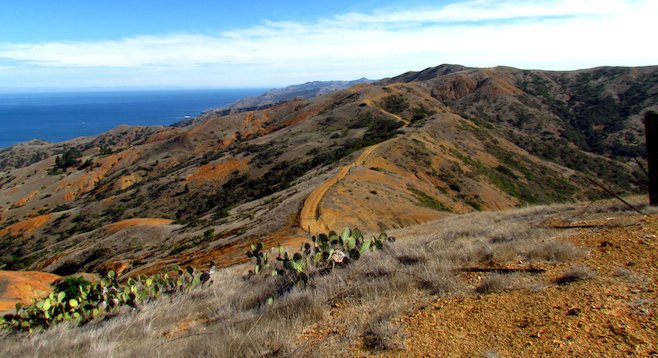 Facebook
Facebook
 X
X
 Instagram
Instagram
 TikTok
TikTok
 Youtube
Youtube

One of seven islands in the Channel Island archipelago, Catalina lies 22 miles due west off Los Angeles. It doesn’t surprise me that the Victorian botanist-poet Blanche Trask took up residence there; it hadn’t been easy for me to return to the mainland after a week traversing the 37-mile Trans-Catalina Trail.
What does surprise – and impress – me is that she had done what few people, let alone women, at the time had done. She had lifted her heavy skirts, scaled the mountain rim surrounding the protected harbor and entered Catalina’s “Interior.”
The Interior is what locals call the area beyond the hills pushing Avalon against the sea and up to the low-lying isthmus town of Two Harbors. Aside from one paved road up to the Airport in the Sky, the Interior, as well as the West End (the tip north of Two Harbors), remains undeveloped and untamed. According to Trask, the island’s “real self lives on unmoved upon the heights – the heights so full of mystery and beauty, seldom seen by any.”
Here’s the thing, though, about those heights so full of mystery. They jut straight out of the sea, and very little has improved the path of ascension since the scantily clad pre-colonial Tongva lived there. When not on buffalo trails or roads, trans-island hikers are scaling fire breaks, most of which cut straight up and drop straight down thousands of feet at unbelievable grades. Although hiking permits can be obtained for free, trekking takes its toll even on the most seasoned.
Nine years ago, the Reader’s very own trail master and alpinist, the late Jerry Schad, referred to the fire breaks used in lieu of trails on the West End as a “sheer descent down the wind-buffeted ridgeline” from “slopes falling precipitously to the emerald-tinted ocean below.”
I ascended the likes of what he had precariously descended, the two-mile vertical Fenceline Trail. With the Pacific in front of me and the San Pedro Channel behind me, I stood on Silver Peak Trail, which spans ten miles along the ridge line, absorbing panoramic, unadulterated vistas.
Trask had said that on those “lonely peaks” there was perfect quiet. She was right. One hundred fourteen years after she described them as such, a profound peacefulness is still settled upon them – which I think is a testament to local preservation efforts. Her rainbow cliffs, thousand-foot-high palisades and “bare and desolate mountains of over-burnt rock…comforted…by the brilliant lichens of green and orange and red and lavender” still remain as intact as when she herself skirted this wild rock in the middle of the ocean.
Descendents of her bald eagles still fish from the cliffsides, and the seeds of her wildflowers still propagate the meadows and deep-gutted canyons. And the breeze is infused with scents of white sage and wild fennel, just as it was a century before.
I was alone on the peak surrounded by heavenly majesty.


One of seven islands in the Channel Island archipelago, Catalina lies 22 miles due west off Los Angeles. It doesn’t surprise me that the Victorian botanist-poet Blanche Trask took up residence there; it hadn’t been easy for me to return to the mainland after a week traversing the 37-mile Trans-Catalina Trail.
What does surprise – and impress – me is that she had done what few people, let alone women, at the time had done. She had lifted her heavy skirts, scaled the mountain rim surrounding the protected harbor and entered Catalina’s “Interior.”
The Interior is what locals call the area beyond the hills pushing Avalon against the sea and up to the low-lying isthmus town of Two Harbors. Aside from one paved road up to the Airport in the Sky, the Interior, as well as the West End (the tip north of Two Harbors), remains undeveloped and untamed. According to Trask, the island’s “real self lives on unmoved upon the heights – the heights so full of mystery and beauty, seldom seen by any.”
Here’s the thing, though, about those heights so full of mystery. They jut straight out of the sea, and very little has improved the path of ascension since the scantily clad pre-colonial Tongva lived there. When not on buffalo trails or roads, trans-island hikers are scaling fire breaks, most of which cut straight up and drop straight down thousands of feet at unbelievable grades. Although hiking permits can be obtained for free, trekking takes its toll even on the most seasoned.
Nine years ago, the Reader’s very own trail master and alpinist, the late Jerry Schad, referred to the fire breaks used in lieu of trails on the West End as a “sheer descent down the wind-buffeted ridgeline” from “slopes falling precipitously to the emerald-tinted ocean below.”
I ascended the likes of what he had precariously descended, the two-mile vertical Fenceline Trail. With the Pacific in front of me and the San Pedro Channel behind me, I stood on Silver Peak Trail, which spans ten miles along the ridge line, absorbing panoramic, unadulterated vistas.
Trask had said that on those “lonely peaks” there was perfect quiet. She was right. One hundred fourteen years after she described them as such, a profound peacefulness is still settled upon them – which I think is a testament to local preservation efforts. Her rainbow cliffs, thousand-foot-high palisades and “bare and desolate mountains of over-burnt rock…comforted…by the brilliant lichens of green and orange and red and lavender” still remain as intact as when she herself skirted this wild rock in the middle of the ocean.
Descendents of her bald eagles still fish from the cliffsides, and the seeds of her wildflowers still propagate the meadows and deep-gutted canyons. And the breeze is infused with scents of white sage and wild fennel, just as it was a century before.
I was alone on the peak surrounded by heavenly majesty.
Comments